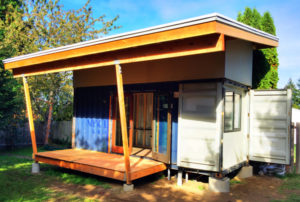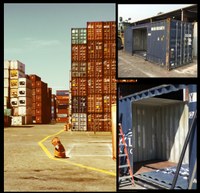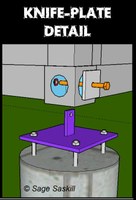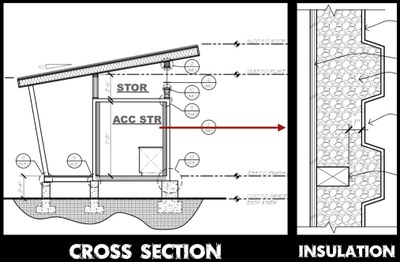Seattle “C-Box” Backyard Cottage from a Shipping Container
Case Study: Published | Updated: | | Seattle, Washington | 2595300175- Category
- category_listing(s)
- Building Type
- Accessory Structure
- Innovation
- Knife Plate Anchor for Shipping Container
- Jurisdiction
- Seattle, Washington
- Parcel
- 2595300175
- Officials
- Team
-
Sage Saskill
|
Designer
Michael Vacirca | builder

Built with a re-purposed blue shipping container by hip Seattle EcoBuilders Sage Saskill and Mike Vacirca, the C-Box was designed as a Detached Accessory Dwelling Unit (DADU), known in Seattle as a “backyard cottage”. Since it would be used as a commercial kitchen to house the owner’s small culinary business, it was permitted as a “shed” i.e. accessory structure (non-dwelling).
The project is a 160 square-foot backyard accessory structure built using a recycled shipping container with interior insulative wall assembly, storage/sleeping loft, bathroom and a commercial kitchen to house a growing small culinary business. By using the loft for storage and not for sleeping (for now), they could permit it as a “shed” and save on permit fees. Later when the business outgrows the space, they plan to convert it to an accessory dwelling. So they built it to meet all requirements for a “backyard cottage” DADU as well as a commercial kitchen.
Instead of hiring a welder to connect the box to the foundation at the construction site, they devised a simple knife-plate steel connector to fit into the container’s existing corner castings, attached to four foundation plinths, at about 1/4th the cost of on-site welding.
| Code Requirement | Compliance Path |
|---|---|
| City of Seattle DCI Directors Rule 7-83 requires a backyard cottage (i.e. detached accessory dwelling unit or DADU) to comply with the 2012 Seattle Residential Code, Chapter 3 Sec. R301 Design Criteria. | Designers submitted a structural engineering analysis to show the proposed structure was equivalent or better than light frame wood construction, “to ensure force transfer, continuity and compatible deformations.” |
| Customer Assistance Memo CAM 116b specifies the permitting process for DADU’s under the Director’s Rule | Although they decided not to permit it as a DADU, the designers met all code requirements under SRC Section R301 so it can later be converted and permitted as such. |
 When the architect submitted the project to land use code officials as a DADU, the planners bounced it back said “No Bed? It’s a Shed.” So it was permitted as a detached accessory structure with a commercial kitchen in it.
When the architect submitted the project to land use code officials as a DADU, the planners bounced it back said “No Bed? It’s a Shed.” So it was permitted as a detached accessory structure with a commercial kitchen in it. The knife plate connectors were fabricated by a welder who worked at the same yard where they bought the container; for $100 each, four for $400. That’s less than 25% of what they would have paid to bring a welder on site.
The knife plate connectors were fabricated by a welder who worked at the same yard where they bought the container; for $100 each, four for $400. That’s less than 25% of what they would have paid to bring a welder on site. Working with a level, plumb steel box made things go up fast. The whole building was constructed in about a week. After installing the footings and knife plates, they flew in the box with a crane which took 2-1/2 hours crane time. Once it was attached, they foamed the interior, framed up the pony walls on top, and buttoned up the roof within 3 days. Interior framing commenced and completed quickly afterwards before they raised a glass and turned the keys over to the satisfied owner!
Working with a level, plumb steel box made things go up fast. The whole building was constructed in about a week. After installing the footings and knife plates, they flew in the box with a crane which took 2-1/2 hours crane time. Once it was attached, they foamed the interior, framed up the pony walls on top, and buttoned up the roof within 3 days. Interior framing commenced and completed quickly afterwards before they raised a glass and turned the keys over to the satisfied owner!